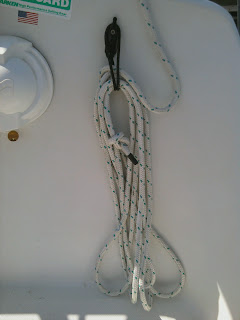Sailing ARROGANCE
ARROGANCE was launched on April 1st. I decided to launch ARROGANCE (my Seaward Fox) for the first part of the sailing season. Main reason was that I made a lot of modifications over the winter and decided it was time to try them all out. So far the decision hasn't been a disappointment. I'll swap her for PERFECTION around Memorial Day for the lazy summer sailing and put ARROGANCE back in for the fall winds.
From my pickup, a view of towing ARROGANCE.
At the launch. View from atop the cabin looking to the bow.
View looking to the stern with the mast crutch.
Launching on a windy day was without any surprises.
ARROGANCE at her slip.
A bow topside view.
Head on bow pulpit view.
ARROGANCE Modifications for 2012
Evinrude 4.5hp Outboard
Repowering with a 4.5hp Evinrude (1982 model and hardly ever used.) versus the Honda 2hp she came with. The reason was because of the F-N-R capability of the Evinrude versus the need to physically swing the Honda 180 degree for reverse and the additional horse power also. Hardly any difference in weight. The adjustable outboard motor mount, no issues regarding shaft length. The external 3 gallon fuel tank slips under the one cockpit seat. That 3 gallons should last me all season.
Through Hull Fitting for Fuel Line
I did added a through hull fitting made from PVC pipe to run the fuel line through the the transom.
Cockpit view of PVC through hull.
Diameter of PVC is large enough so the fuel fitting will easily pass through to outboard.
Fuel line passing through to outboard.
LED Lighting
The lighting, both interior and exterior has been switched over to LED lighting. Big power savings. I've added a solar collector for the gel cell battery recharging. I also added shore power hook up so if need be I can also use a small generator.
Control Lines for Sails
All the sail control lines lead back to the cockpit so there is very little need to go forward other than leaving or returning to the dock. Lines are color coded of course. The lazy jack lines on the main sail are fantastic. No more be covered by the main sail when dropping it. Needless to say, the cockpit is clutter free.
Bimini
A bimini was also a new addition. My first mate will enjoy the shade. When stowed it leans back against the stern out of the way.
Turnbuckle Covers from PVC Pipe
I added turnbuckle covers made out of PVC pipe. Very easy and economical to make versus purchasing. All one needs to do is decide on the diameter needed, length of pipe and drill a hole through the pipe cap to thread the stay through. Do Not Glue! Easier on the sails, lines and toes.
The open Turnbuckle
Electrical PVC Conduit for the body and PVC Cap
The finished cover. Note the hole in the PVC Cap. This allows one to easily slide the PVC Turnbuckle Cover for checking the Turnbuckle and cotter rings.
The completed PVC Turnbuckle Cover.
Sailing ARROGANCE in 2012
Sailing has been fantastic. The April weather has been less than perfect conditions we had in March.
Stanchion Cam
I mounted a digital camera to take videos on board while under sail. To do so, I attached a small tripod to the lifeline stanchions on both the stern port and starboard sides. I found the tripods at Dollar Tree. Great price...$1 a piece. As for attaching to the stanchions, I used plastic electrical tape. Yes, very low tech but they do a fantastic job! Just to make sure I wouldn't lose the camera overboard by accident, I attached it's lanyard to the lifeline.
The videos that follow are from the stanchion cam.
The videos (Click both to Play at once).
ARROGANCE on a nice run:
and me, At The Helm:



















































